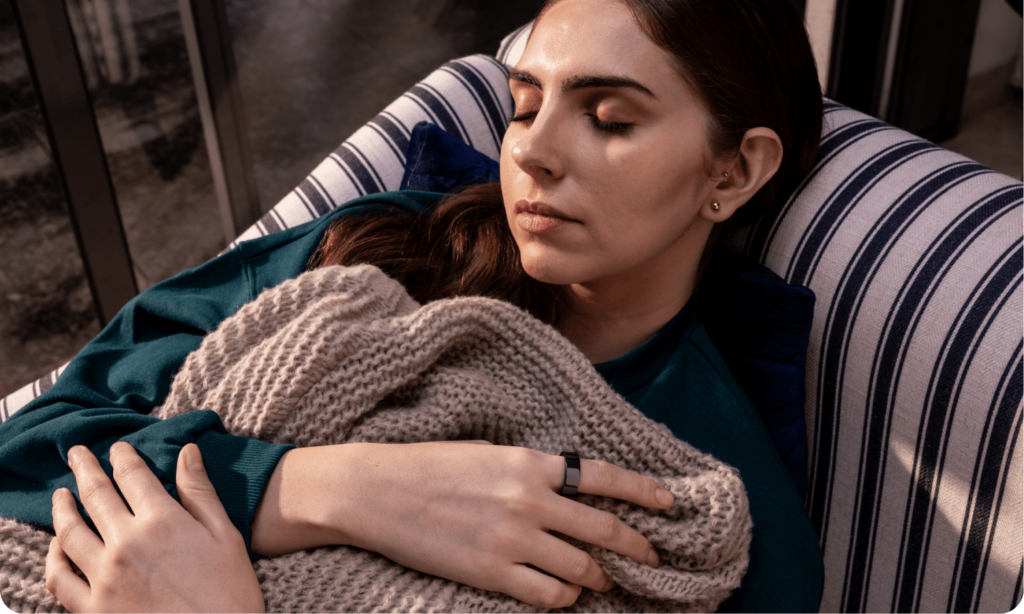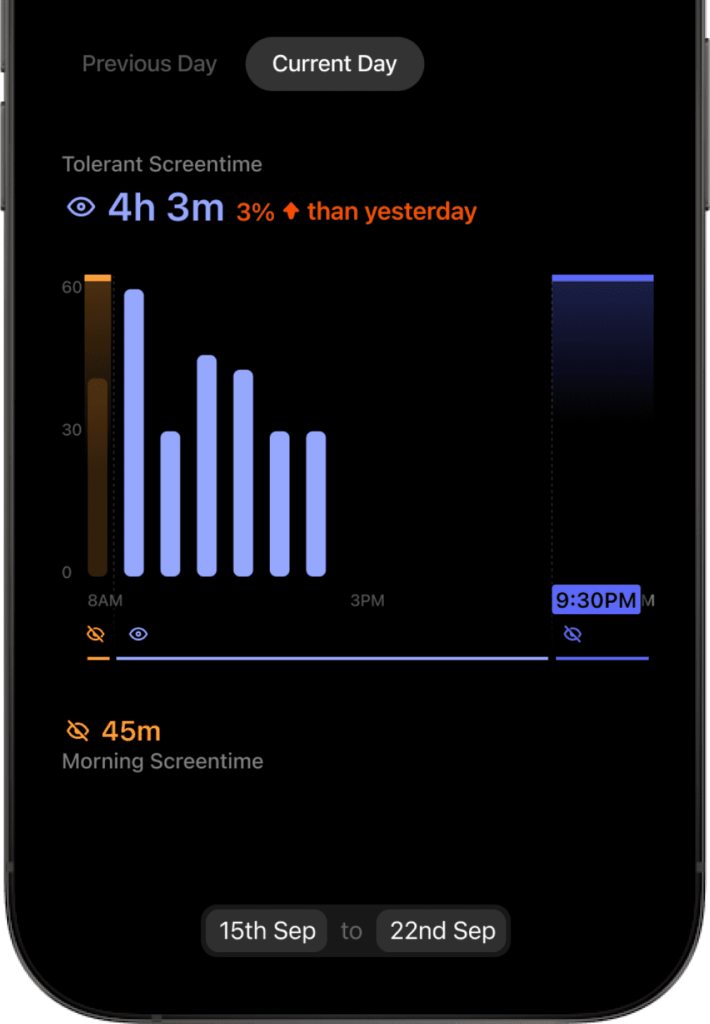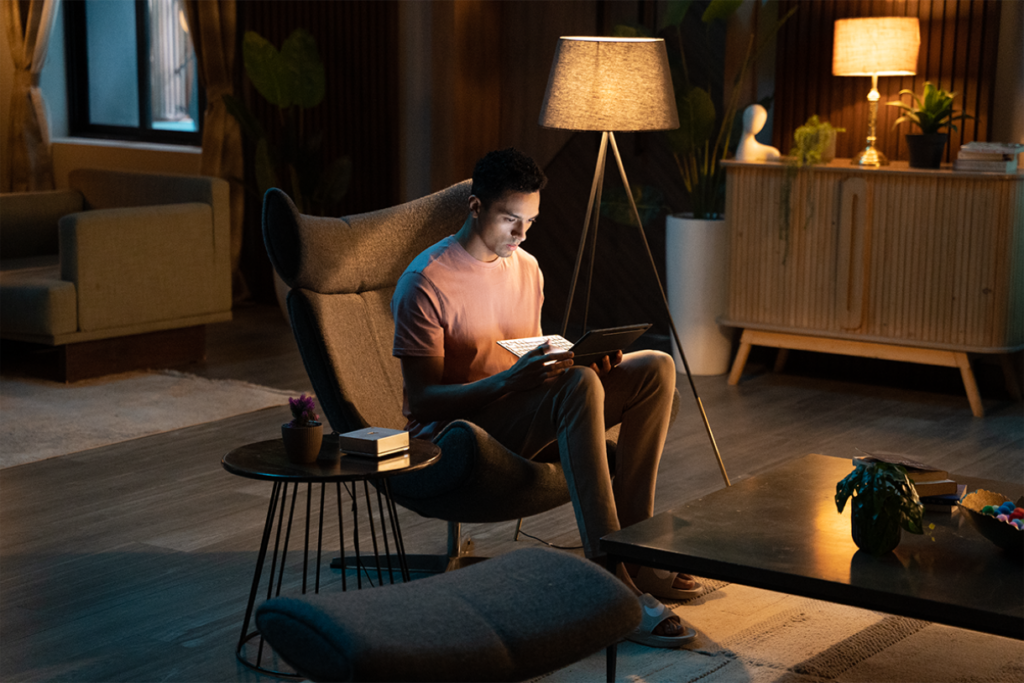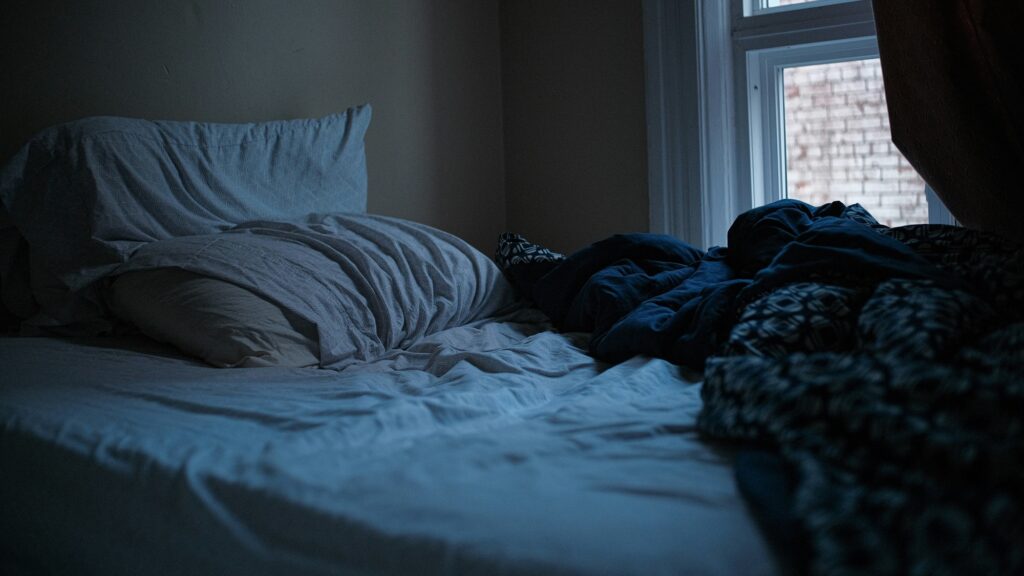In today’s hyper-connected world, our screens have become both windows and mirrors – portals to endless information and reflections of our daily habits. But as we swipe, tap, and scroll through life, it’s all too easy to get swept away in a current of excessive Screen Time. This digital undertow can undermine our well-being, affecting everything from our sleep patterns to our mental health. As we navigate this new world, it would be helpful to be more mindful of these digital tides learn to ride them the right way, and optimise for overall well-being in the process.
This digital undertow can undermine our well-being, affecting everything from our eye health and attention span in the short term to our sleep patterns and mental health in the long term. As we navigate this new world, being mindful of these digital effects on our bodies and learning to manage them the right way is crucial for overall well-being.
Introducing Screen Time, a PowerPlug by Ultrahuman designed to help you be more mindful of your digital life.
While sunlight is made of a wide range of photonic wavelengths, light-emitting screens usually emit “blue spectrum” light (400-490 nm)[1] (Source: UC Davis Health). In moderation, blue light increases mental acuity and alertness, but with Screen Time exceeding 10 hours or more nowadays, the blue light causes considerable eye strain and disrupts circadian cycles which negatively affect sleep, next-morning alertness and body rhythms.
Specifically, screen viewing time before bed suppresses melatonin production and disrupts REM sleep, leading to delayed sleep onset, fragmented sleep cycles, and altered sleep stages. These disruptions can result in emotional instability, impaired memory, and chronic sleep deprivation, ultimately increasing health risks[2]
Additionally research has found a strong correlation between digital screen use and dry eye disease [3]( that can cause eye damage and mental health problems like anxiety and depression.
The Screen Time PowerPlug comprises various phases, geared towards building positive digital habits. These phases are personalized, which means they are calculated based on your sleep baseline.
The Components of Screen Time
The Screen Time PowerPlug comprises various phases, geared towards nudging you to build positive digital habits. These phases are calculated based on your individual sleep baseline.
Morning Restriction Window
When you wake up, the body slowly comes to full alertness. A sudden steep rise in blue light emitted by screens can disrupt the natural flow. Instead, exposing our eyes to sunlight allows for the full spectrum of light to reach the eyes, allowing for a healthier transition to an active state.
The Morning Restriction Window understands this context. It is active for one hour after you wake up, during which it nudges you towards a better morning digital routine.

Tolerant Phase
This phase is active after your Morning Restriction Window is complete. During this phase, you can use your screen mindfully and go about your day. This will not have an impact on your sleep.

Wind down Phase
Research indicates that screen time close to bedtime can lead to delayed sleep onset, shorter sleep duration, and disruptions in sleep architecture [4]
The Wind Down Phase considers the effects of phone use 3 hours before bed. It understands that positive pre-bedtime behaviour can allow for better sleep, nudging you towards healthier digital behaviour.

Screen Time Restriction Window
Research[5] indicates that using screens before bed can lead to difficulties falling asleep, shorter sleep duration, and daytime somnolence, a state of drowsiness or a strong desire to sleep during the day. Additionally, exposure to short-wavelength light emitted by screens can disrupt melatonin secretion, affecting sleep quality.

For instance, if you typically wake at 8:00 AM, your Morning Restriction Window extends until 9:00 AM, followed by the Tolerant Phase. Assuming a sleep baseline of 11:00 PM, your Wind Down Phase would begin at 8:00 PM, with the Restriction Window starting at 10:00 PM.
This PowerPlug adapts to your sleep patterns; if you sleep later than usual, it extends the Wind Down and Restriction Windows accordingly, highlighting the potential impact of Screen Time on your sleep quality.
Screen Time Restriction Window understands that phone use 1 hour before your usual bedtime can be stimulating, and can have negative second-order effects on sleep. Keeping this in mind, the PowerPlug activates the restriction window one hour before your sleep time.
Screen Time understands that everyone’s sleep schedule is different. It is designed to adapt to your sleep patterns. For instance, if you sleep later than usual, it extends the Wind Down and Restriction Windows accordingly.
How does Screen Time impact sleep?
Excessive Screen Time, particularly before bed, can have more specific consequences on sleep patterns, including the impact on REM (Rapid Eye Movement) sleep and melatonin production:

1. Suppression of Melatonin Production:
- Blue Light Exposure[6]: The blue light emitted by screens (from smartphones, tablets, computers, and TVs) is particularly effective at suppressing melatonin production. Melatonin is a hormone that signals to your body that it’s time to sleep, helping to regulate your sleep-wake cycle.
- Delayed Sleep Onset[7]: Reduced melatonin levels can delay the onset of sleep, meaning it takes longer to fall asleep after screen exposure. This delay can shift your entire sleep cycle, leading to difficulty waking up at your usual time.
2. Impact on REM Sleep:
- Reduced REM Sleep[8]: REM sleep is a crucial stage of sleep associated with dreaming, memory consolidation, and emotional processing. Excessive Screen Time, especially before bed, can reduce the amount of time spent in REM sleep.
- Emotional Regulation and Memory [9]: Since REM sleep is critical for emotional regulation and memory consolidation, reduced or fragmented REM sleep can impair cognitive functions, such as memory retention and problem-solving skills.
3. Shifted Sleep Architecture:
- Altered Sleep Stages [10]: Screen Time before bed can alter the balance of your sleep stages, leading to less time spent in the deeper stages of sleep (including REM and deep sleep) and more time in lighter sleep stages. This shift can reduce the restorative quality of your sleep, leaving you feeling less refreshed in the morning.
- Sleep Cycle Disruption[11]: Regular screen use before bed can lead to a consistent disruption in your natural sleep cycles, affecting the overall architecture of your sleep. This disruption can make it harder for your body to achieve the full range of restorative benefits that come from a healthy sleep pattern.
4. Increased Sleep Latency [12]
- Prolonged Sleep Latency [13]: The time it takes to transition from wakefulness to sleep is known as sleep latency. Excessive screen use can increase sleep latency, making it more challenging to transition into the first sleep stage. This delay can lead to a reduction in overall sleep duration and contribute to a feeling of grogginess in the morning.
5. Long-Term Consequences[14]:
- Chronic Sleep Deprivation: Over time, the cumulative effects of reduced REM sleep, melatonin suppression, and altered sleep architecture can lead to chronic sleep deprivation. This state is associated with a wide range of health issues, including weakened immune function, increased risk of cardiovascular diseases, obesity, and impaired mental health.
To counteract these effects, it’s crucial to practice good sleep hygiene, including limiting screen use at least an hour before bedtime, using blue light filters if necessary, and establishing a calming pre-sleep routine. This can help protect the natural production of melatonin, promote healthier REM sleep, and support overall better sleep quality.

How can Screen Time help you?
Screen Time PowerPlug is a game-changer for your health.
You now have access to direct correlations between your screen time and sleep duration & quality.
A 7-day history report allows you to track these insights over a longer timeframe, enabling you to understand positive and negative patterns. You’ll also receive notifications at the start of each phase, allowing you to plan your phone use effectively throughout the day.
How to start using the Screen Time PowerPlug?
To maximise the benefits of this PowerPlug, grant it access to your device’s Screen Time data.
Conclusion
The Screen Time PowerPlug from Ring AIR offers a powerful tool to enhance your digital wellness and sleep quality. By providing personalized insights and gentle reminders, it empowers you to make more mindful choices about your screen time habits. Taking this step towards a healthier relationship with technology can have far-reaching benefits for your sleep, productivity, and overall well-being.
Head to the Screen Time PowerPlug on the Ultrahuman App today and start your journey towards a more balanced digital lifestyle.
References
- https://health.ucdavis.edu/blog/cultivating-health/blue-light-effects-on-your-eyes-sleep-and-health/2022/08
- https://pubmed.ncbi.nlm.nih.gov/25535358/
- https://www.ncbi.nlm.nih.gov/pmc/articles/PMC8439964/
- https://pubmed.ncbi.nlm.nih.gov/38471778/
- https://pubmed.ncbi.nlm.nih.gov/25535358/
- https://pubmed.ncbi.nlm.nih.gov/25535358/
- https://pubmed.ncbi.nlm.nih.gov/25390034/
- https://pubmed.ncbi.nlm.nih.gov/16272890/
- https://www.ncbi.nlm.nih.gov/pmc/articles/PMC7181893/
- https://www.ncbi.nlm.nih.gov/pmc/articles/PMC7181893/
- https://www.ncbi.nlm.nih.gov/pmc/articles/PMC7181893/
- https://www.ncbi.nlm.nih.gov/pmc/articles/PMC7181893/
- https://www.ncbi.nlm.nih.gov/pmc/articles/PMC4182440/
- https://www.ncbi.nlm.nih.gov/pmc/articles/PMC7181893/








